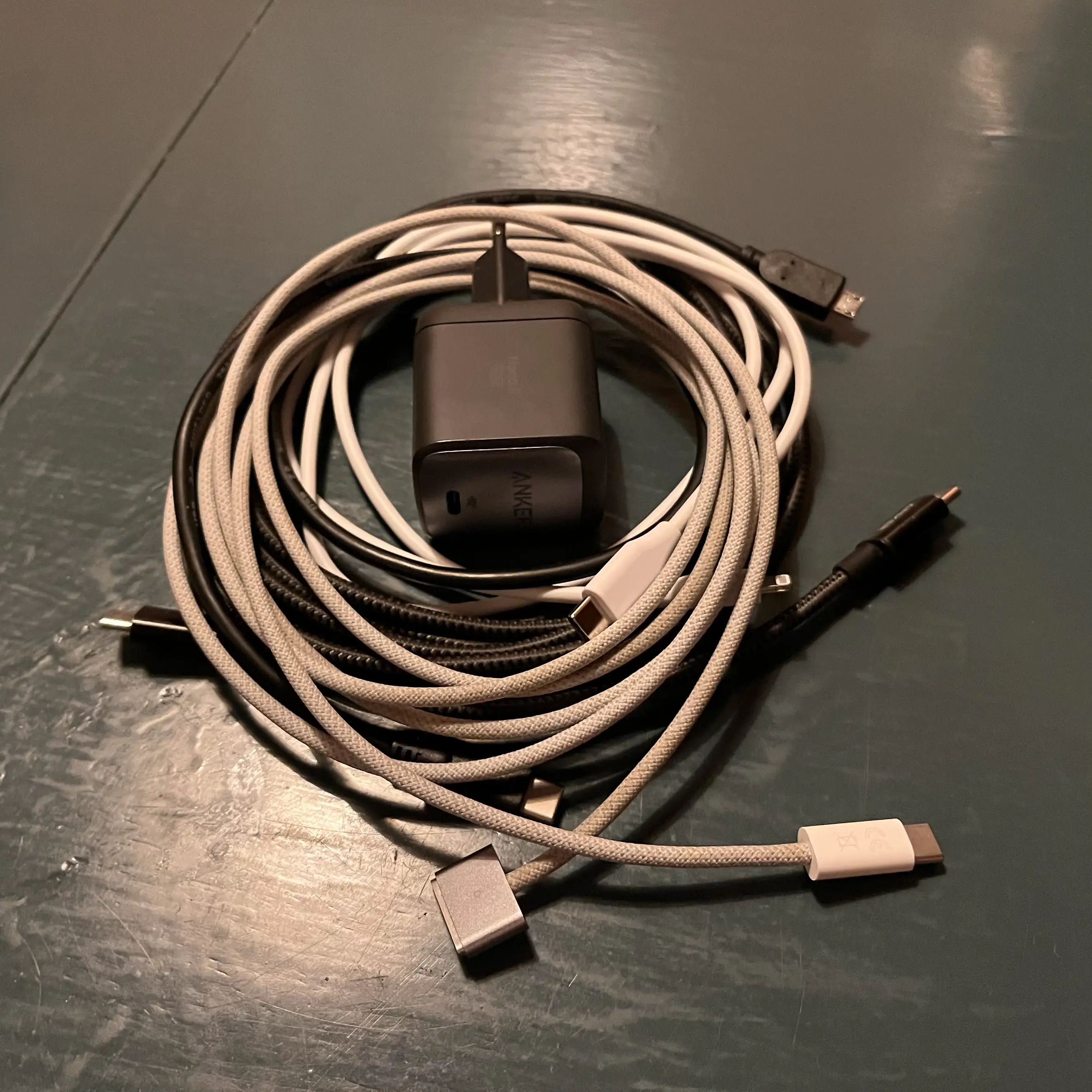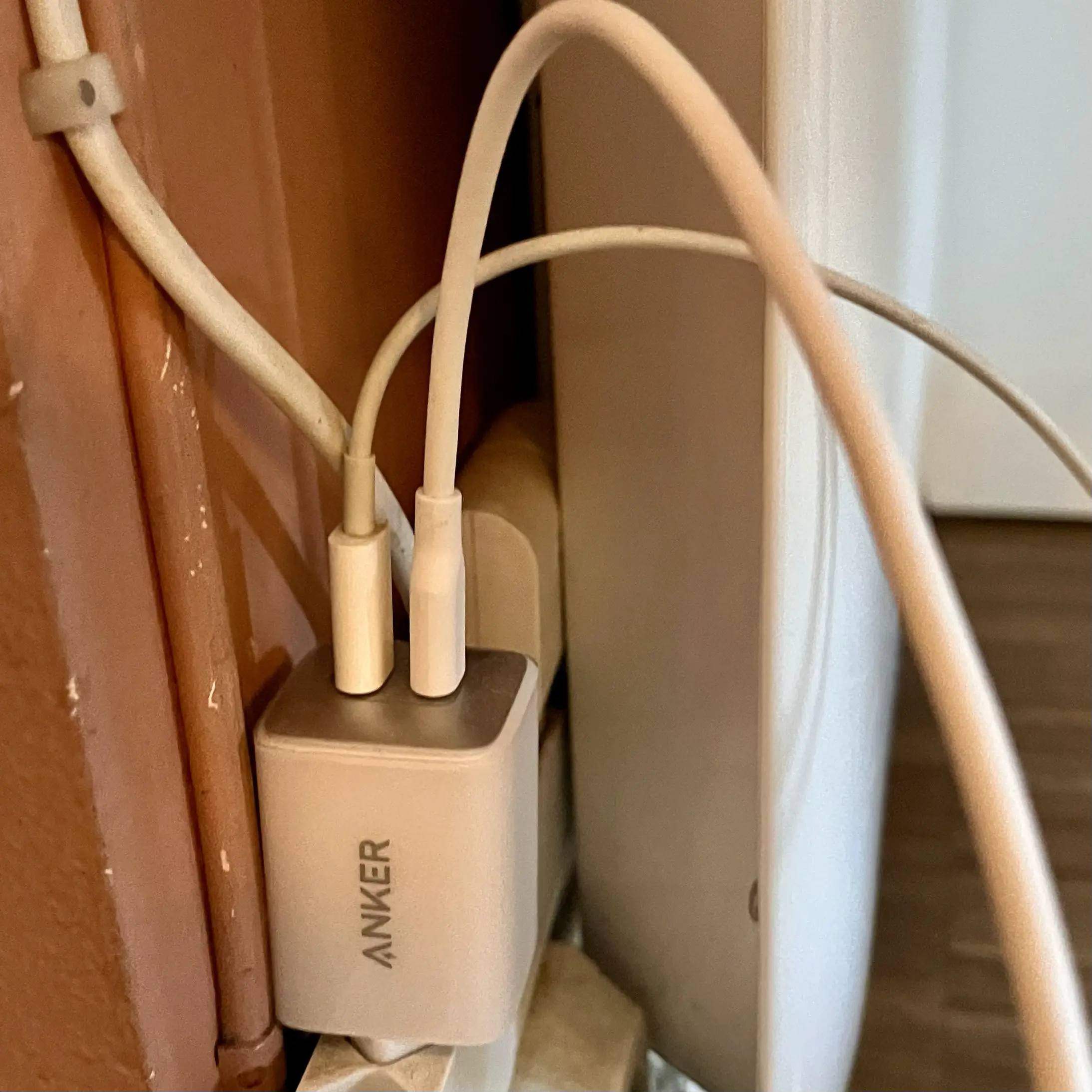I Love My Little Charging Bundle
I recently wrote about not needing USB-A, and mentioned the USB-C Lifestyle™️. That reminded me of a little bundle of cables I always keep in my backpack. So here are some …
Advice for frustration-free charging
1) Buy extra
Here’s my bundle:
The trick is that I don’t need any of these elsewhere – they are extra. I have other chargers in my office, next to my bed, etc. I get that this is a bit more wasteful than just having one charger that you move around everywhere. But I think this is resource spending that’s worth it – and hopefully the devices you buy don’t come with (sub-par) chargers you don’t need. Furthermore, try to keep chargers for a long time.
2) Think about colour and texture of the cables
These are the cables in the bundle:
- USB-C, 3 meters (black, braided)
- MagSafe for Mac (light gray, braided)
- Lightning, 1 meter (white)
- Micro-USB (black)
As you can see, all of them have a different combination of colour and texture. This makes it easier to pick out the correct one!
3) Don’t buy “original” chargers
In general, buying “original” accessories will give you something that might be pricier, but at least is among the best. But when it comes to chargers, and especially compared to Apple, the third-party chargers are objectively better. The reason being that Apple doesn’t use GaN, a relatively new technology that allows for significantly smaller size to power ratio.
Mine’s a 65 watt Anker charger 🖇️, that I really like. Because while I don’t necessarily recommend getting chargers from Apple/Samsung/etc., I do recommend getting a “name-brand” one. Anker is a brand I’ve always been pleased with, so I haven’t tried many others. But I think Ugreen and Belkin might be decent as well. Would love to hear about it if you have other recommendations I can add here!
4) Get enough wattage, but not more
The number you want to look at when buying chargers, is the wattage. Here’s an overview:
- 5 watts: The old, little iPhone chargers. Not worth using.
- 20 watts: Great for phones, adequate for tablets. Will charge most laptops, but a bit slowly.
- 30 watts: Good for tablets, adequate for laptops.
- 65 watts: Around the max for devices like the MacBook Air. More than fast enough for my MacBook Pro as well.
- 100 watts: Great for fast charging of more demanding laptops.
There’s no issue with using a more powerful charger than necessary – you can safely plug your phone in a 100-watt charger. But they become larger, and more expensive, as they increase in size – so that’s why I recommend getting enough, but not more.
In general, I use 30 watts for chargers I have “here and there” – and I carry 65 watts in my backpack. I’ve never needed more.
5) Consider having fewer(!) ports
I get the urge of buying chargers with more than one port –** and occasionally that’s absolutely a great option**.
The charger above is in my kitchen, with a MagSafe puck 🖇️ and USB-C cable always connected. It provides 47 watts – but that’s, obviously, shared between the ports. It tries to doll out the power to where it’s needed – but it doesn’t always work flawlessly. So sometimes I have to unplug the MagSafe puck to get more juice for the USB-C cable (even though I don’t have any devices on the puck).
But for the times when you “always” need two outputs, I’d still go for one of these. But the reason I went for the one-port-version for my backpack, is that I really like the simplicity and reliability of always knowing what you’re getting. When I want to charge several things at once, I can usually charge through another device. For instance, I’ll charge my phone via my iPad or MacBook, or iPad via the MacBook.
Bonus recommendation: 3-in-1 charger(s)
If you have a smartwatch, like my wife, you might want something other than just loose cables for your travels. So I bought this for her one Christmas:
This is the Mophie 3-in-1 charger. There are many variants of 3-in-1 chargers, but the 2023 version of the Mophie charger has two important details:
- The MagSafe/Qi 2 pad in the middle charges the full 15 watts,
- and the Apple Watch can fast charge.
The latter is not true of the previous versions of the Mophie charger.
So, when researching these chargers, always check the charging speed of the different parts! However, if you always charge over-night, you might not need the fastest charging – and something like form-factor might weigh more. I’m just saying it’s good to be aware. Also, keep in mind how powerful the power brick needs to be.1
So, my summation is:
- Buy extra. Don’t just move around one charger. (My wife only uses the Mophie above while traveling.)
- Think about colour and texture of the cables, to make the different types easy to pick out.
- Don’t buy “original” chargers. Instead, buy name-brand GaN chargers, from brands like Anker.
- Get enough wattage, but not more. 20 watts for phones and tablets, 30 watts for phones, tablets and consumer laptops, and 65 watts for everything mentioned above, but also pro laptops. 100 watts is more niche.
- Consider getting fewer ports, as this is simpler and more reliable.
- Check charging speed, especially when buying chargers that can charge several devices at once.
Edit: I got an «answer post» from Eric, that I liked! 👌🏻
-
For the Mophie, it’s at least 30 watt. ↩︎






